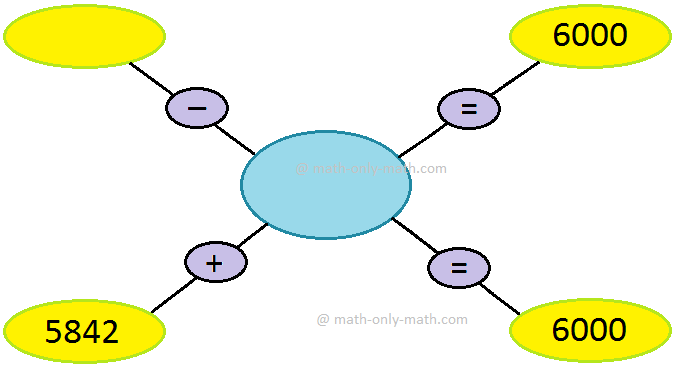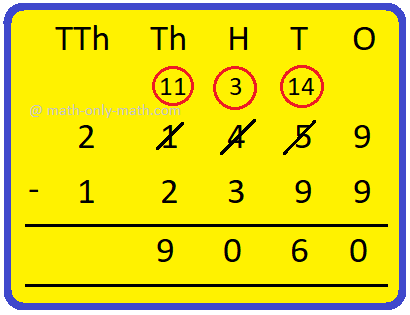Bisector of the Angle which Contains the Origin
We will learn how to find the equation of the bisector of the angle which contains the origin.
Algorithm to determine whether the origin lines in the obtuse angle or acute angle between the lines
Let the equation of the two lines be a\(_{1}\)x + b\(_{1}\)y + c\(_{1}\) = 0 and a\(_{2}\)x + b\(_{2}\)y + c\(_{2}\) = 0.
To determine whether the origin lines in the acute angles or obtuse angle between the lines we proceed as follows:
Step I: Obtain whether the constant terms c\(_{1}\) and c\(_{2}\) in the equations of the two lines are positive or not. Suppose not, make them positive by multiplying both sides of the equations by negative sign.
Step II: Determine the sign of a\(_{1}\)a\(_{2}\) + b\(_{1}\)b\(_{2}\).
Step III: If a\(_{1}\)a\(_{2}\) + b\(_{1}\)b\(_{2}\) > 0, then the origin lies in the obtuse angle and the “ + “ symbol gives the bisector of the obtuse angle. If a\(_{1}\)a\(_{2}\) + b\(_{1}\)b\(_{2}\) < 0, then the origin lies in the acute angle and the “ Positive (+) “ symbol gives the bisector of the acute angle i.e.,
\(\frac{a_{1}x + b_{1}y + c_{1}}{\sqrt{a_{1}^{2} + b_{1}^{2}}}\) = + \(\frac{a_{2}x + b_{2}y + c_{2}}{\sqrt{a_{2}^{2} + b_{2}^{2}}}\)
Solved examples on the equation of the bisector of the angle which contains the origin:
1. Find the equations of the two bisectors of the angles between the straight lines 3x + 4y + 1 = 0 and 8x - 6y - 3 = 0. Which of the two bisectors bisects the angle containing the origin?
Solution:
3x + 4y + 1 = 0 ……….. (i)
8x - 6y - 3 = 0 ……….. (ii)
The equations of the two bisectors of the angles between the lines (i) and (ii)
\(\frac{3x + 4y + 1}{\sqrt{3^{2} + 4^{2}}}\) = + \(\frac{8x - 6y - 3}{\sqrt{8^{2} + (-6)^{2}}}\)
⇒ 2 (3x + 4y + 1) = (8x - 6y - 3)
Therefore, the required two bisectors are given by,
6x + 8y + 2 = 8x+ 6y - 3 (taking `+' sign)
⇒ 2x - 14y = 5
And 6x+ 8y + 2 = - 8x + 6y + 3 (taking `-' sign)
⇒ 14x + 2y = 1
Since the constant terms in (i) and (ii) are of opposite signs, hence the bisector which bisects the angle containing the origin is
2 (3x + 4y + 1) = - (8x - 6y - 3)
⇒ 14x + 2y= 1.
2. For the straight lines 4x + 3y - 6 = 0 and 5x + 12y + 9 = 0 find the equation of the bisector of the angle which contains the origin.
Solution:
To find the bisector of the angle between the lines which contains the origin, we first write down the equations of the given lines in such a form that the constant terms in the equations of the lines are positive. The equations of the given lines are
4x + 3y - 6 = 0 ⇒ -4x - 3y + 6 = 0 ……………………. (i)
5x + 12y + 9 = 0 ……………………. (ii)
Now the equation of the bisector of the angle between the lines which contains the origin is the bisector corresponding to the positive symbol i.e.,
\(\frac{-4x - 3y + 6}{\sqrt{(-4)^{2} + (-3)^{2}}}\) = + \(\frac{5x + 12y + 9}{\sqrt{5^{2} + 12^{2}}}\)
⇒ -52x – 39 y + 78 = 25x + 60y + 45
⇒ 7x + 9y – 3 = 0
Form (i) and (ii), we have a1a2 + b1b2 = -20 – 36 = -56 <0.
Therefore, the origin is situated in an acute angle region and the bisector of this angle is 7x + 9y – 3 = 0.
● The Straight Line
- Straight Line
- Slope of a Straight Line
- Slope of a Line through Two Given Points
- Collinearity of Three Points
- Equation of a Line Parallel to x-axis
- Equation of a Line Parallel to y-axis
- Slope-intercept Form
- Point-slope Form
- Straight line in Two-point Form
- Straight Line in Intercept Form
- Straight Line in Normal Form
- General Form into Slope-intercept Form
- General Form into Intercept Form
- General Form into Normal Form
- Point of Intersection of Two Lines
- Concurrency of Three Lines
- Angle between Two Straight Lines
- Condition of Parallelism of Lines
- Equation of a Line Parallel to a Line
- Condition of Perpendicularity of Two Lines
- Equation of a Line Perpendicular to a Line
- Identical Straight Lines
- Position of a Point Relative to a Line
- Distance of a Point from a Straight Line
- Equations of the Bisectors of the Angles between Two Straight Lines
- Bisector of the Angle which Contains the Origin
- Straight Line Formulae
- Problems on Straight Lines
- Word Problems on Straight Lines
- Problems on Slope and Intercept
11 and 12 Grade Math
From Bisector of the Angle which Contains the Origin to HOME PAGE
Didn't find what you were looking for? Or want to know more information about Math Only Math. Use this Google Search to find what you need.
Recent Articles
-
3rd Grade Subtraction Worksheet | 3-Digit Subtraction Worksheets | Ans
Jan 14, 25 01:20 AM
In 3th Grade Addition Worksheet we will solve how to subtract 3-digit numbers by expansion, subtraction of 3-digit numbers without regrouping, subtraction of 3-digit numbers with regrouping, propertie… -
Facts about Subtraction | Subtraction of Small Numbers|Solved Examples
Jan 14, 25 12:29 AM
The operation to finding the difference between two numbers is called subtraction. Let us know some facts about subtraction which will help us to learn subtraction of large numbers. 1. Subtraction wit… -
Word Problems on Subtraction |Worksheet on Subtraction Word Problems |
Jan 14, 25 12:21 AM
In word problems on subtraction we need to read the question carefully and understand what we need to find out. We know, in subtraction the larger number from which we subtract the other number (the s… -
Worksheet on Estimating Sums and Differences | Find the Estimated Sum
Jan 13, 25 01:34 PM
In 4th grade worksheet on estimating sums and differences, all grade students can practice the questions on estimations.This exercise sheet on estimating sums and differences can be practiced -
Worksheet on Mixed Addition and Subtraction | Questions on Addition
Jan 12, 25 02:14 PM
In worksheet on mixed addition and subtraction the questions involve both addition and subtraction together; all grade students can practice the questions on addition and subtraction together.




New! Comments
Have your say about what you just read! Leave me a comment in the box below. Ask a Question or Answer a Question.